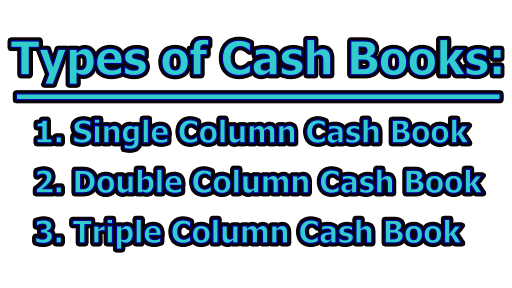Importance and Types of Cash Books:
A cash book is a specialized accounting journal used to record all cash transactions, including receipts and payments. Unlike a general ledger, a cash book serves the dual purpose of being both a journal and a ledger, eliminating the need for a separate cash account. This essential financial tool tracks the cash position of an organization, ensuring accurate financial reporting, liquidity management, and transparency in cash management processes. By maintaining a well-organized cash book, businesses can avoid cash shortages, detect discrepancies promptly, and ensure smooth daily operations. In the rest of this article, we are going to explore the importance and types of cash books based on the complexity and nature of transactions.
Importance of Cash Books:
Cash books are integral to the financial framework of businesses for the following reasons:
- Accurate Financial Record-Keeping: Cash books ensure the accurate recording of every cash and bank transaction. By documenting receipts and payments in chronological order, they help businesses maintain precise and up-to-date financial records. This accuracy is crucial for preparing reliable financial statements, tax filings, and audit reports.
- Effective Cash Flow Management: Proper cash flow management is essential for the survival and growth of any business. The cash book allows businesses to monitor daily cash inflows and outflows, helping to avoid cash shortages or surpluses. With real-time visibility into cash positions, businesses can plan payments, investments, and other financial decisions more effectively.
- Simplified Bank Reconciliation: Bank reconciliation is the process of comparing the cash book’s bank entries with the corresponding bank statements to identify and resolve discrepancies. A well-maintained cash book simplifies this process by providing accurate, up-to-date bank transaction records. This reconciliation ensures that all bank transactions are accurately reflected, detecting any errors or fraudulent activities early on.
- Facilitating Internal Control: Cash books play a pivotal role in maintaining internal financial control. By documenting every cash and bank transaction, they provide an audit trail that can be traced and verified. This transparency deters fraudulent practices, minimizes errors, and ensures accountability among employees handling financial transactions.
- Aiding in Budgeting and Forecasting: With a comprehensive record of past financial transactions, cash books serve as an essential reference for budgeting and forecasting future financial activities. Historical cash flow data can be analyzed to predict future cash requirements, plan for investments, and allocate resources efficiently. This predictive capability helps businesses to set realistic financial goals and achieve them.
- Providing Legal and Tax Evidence: Maintaining a cash book ensures that all financial transactions are documented, which is essential for legal compliance and tax purposes. In case of disputes, audits, or tax inspections, the cash book serves as credible evidence of transactions. This documentation helps businesses meet regulatory requirements and avoid potential legal complications.
- Supporting Decision-Making: Accurate and timely financial information from cash books enables management to make informed decisions regarding business operations, investments, and expansions. By analyzing patterns in cash inflows and outflows, businesses can identify profitable ventures, cut unnecessary expenses, and optimize resource utilization.
- Enabling Quick Financial Reviews: Unlike ledgers, which may require cross-referencing multiple accounts, cash books provide a consolidated view of all cash and bank transactions. This consolidated record allows for quick financial reviews, making it easier for management to assess liquidity, track financial performance, and respond promptly to financial issues.
- Serving as a Foundation for Final Accounts: The cash book lays the groundwork for preparing final accounts, such as the income statement and balance sheet. Since it acts as both a journal and ledger for cash and bank transactions, information from the cash book can be directly used in the preparation of these financial statements, ensuring accuracy and consistency.
- Reducing Accounting Errors: By centralizing the recording of cash and bank transactions, cash books reduce the risk of accounting errors. Regular balancing and reconciliation help in detecting and correcting discrepancies promptly. This accuracy not only streamlines the accounting process but also enhances the reliability of financial information.
Types of Cash Books:
Depending on the complexity and type of transactions, cash books are divided into three primary categories:
1. Single Column Cash Book:
The Single Column Cash Book is the simplest and most fundamental form of a cash book, designed to record only cash transactions. It is especially suitable for small businesses, sole proprietors, and organizations that handle minimal cash transactions without involving bank dealings or discounts. This cash book features a single amount column on each side: the debit side records cash receipts, and the credit side records cash payments. Since it deals exclusively with cash transactions, there is no provision for recording bank or discount entries.
Key Features of Single Column Cash Book:
- Simplicity: Easy to maintain and understand, making it ideal for small businesses.
- Cash Transactions Only: Records cash receipts on the debit side and cash payments on the credit side.
- Real-Time Cash Position: Helps in determining the actual cash position of a business at any given time.
- No Bank or Discount Records: Excludes any entries related to bank transactions or discounts.
- Double Entry Aspect: Functions both as a journal and a ledger, eliminating the need to open a separate cash account in the ledger.
Format of a Single Column Cash Book: The format of a single column cash book typically includes the following columns:
- Date: The date on which the transaction occurs.
- Particulars: A description of the transaction.
- F. (Ledger Folio): Reference to the page number of the ledger where the corresponding entry is posted.
- Cash (Dr): Cash received (on the debit side).
- Cash (Cr): Cash paid (on the credit side).
Illustration:
| Date | Particulars | L.F. | Cash (Dr) | Cash (Cr) |
| 2025-01-01 | Capital Introduced | 001 | $10,000 | |
| 2025-01-02 | Cash Sales | 002 | $3,000 | |
| 2025-01-03 | Purchase of Goods | 003 | $4,000 | |
| 2025-01-05 | Rent Paid | 004 | $1,000 | |
| 2025-01-06 | Received from Customer A | 005 | $1,500 | |
| 2025-01-08 | Electricity Bill Paid | 006 | $500 |
Explanation of Transactions:
- Capital Introduced (2025-01-01): The owner invested $10,000 in the business.
- Cash Sales (2025-01-02): The business earned $3,000 through cash sales.
- Purchase of Goods (2025-01-03): Goods worth $4,000 were purchased with cash.
- Rent Paid (2025-01-05): Monthly rent of $1,000 was paid in cash.
- Received from Customer A (2025-01-06): Customer A settled their dues of $1,500 in cash.
- Electricity Bill Paid (2025-01-08): The business paid $500 towards the electricity bill.
Balancing the Single Column Cash Book: At the end of a given period (daily, weekly, or monthly), the single column cash book needs to be balanced. The process involves:
- Summing Up Receipts and Payments: Add up the total receipts on the debit side and the total payments on the credit side.
- Calculating the Closing Balance: Subtract the total payments from the total receipts. The closing balance represents the cash available at the end of the period.
- Carrying Forward the Balance: The closing balance is carried forward to the next period as the opening balance.
Example of Balancing:
- Total Cash Receipts: $14,500 ($10,000 + $3,000 + $1,500)
- Total Cash Payments: $5,500 ($4,000 + $1,000 + $500)
- Closing Balance: $9,000 ($14,500 – $5,500)
The closing balance of $9,000 is shown on the credit side to balance the cash book and is then brought forward to the next period on the debit side.
Advantages of Single Column Cash Book:
- Easy Maintenance: Simple structure makes it easy to maintain without specialized accounting knowledge.
- Quick Access to Cash Data: Provides a real-time overview of cash transactions and available cash balance.
- Cost-Effective: Suitable for businesses with limited transactions, avoiding the need for complex accounting systems.
- Error Detection: Facilitates the easy detection of discrepancies or errors in cash handling.
Disadvantages of Single Column Cash Book:
- Limited Scope: Inadequate for businesses with frequent bank transactions or those offering discounts.
- No Bank Reconciliation: Lack of bank-related records can complicate reconciliation processes.
- Vulnerability to Fraud: Limited internal controls increase susceptibility to misappropriation of cash.
2. Double Column Cash Book:
The Double Column Cash Book is an advanced version of the single column cash book, designed to record both cash and bank transactions. It features two columns on each side: one for cash and another for bank transactions. This cash book is suitable for businesses that frequently deposit cash into the bank or withdraw cash from the bank, offering a more comprehensive record of financial activities. By combining cash and bank records in a single book, it simplifies the accounting process and facilitates efficient bank reconciliation.
Key Features of Double Column Cash Book:
- Dual Recording: Tracks both cash and bank transactions simultaneously.
- Efficient Bank Reconciliation: Simplifies the process of matching cash book entries with bank statements.
- Enhanced Cash Flow Tracking: Provides a clearer picture of liquidity by capturing cash and bank movements.
- Suitable for Growing Businesses: Ideal for businesses with moderate transaction volumes involving banks.
- Journal and Ledger Functions: Acts as both a journal and a ledger, eliminating the need for separate bank and cash ledger accounts.
Format of a Double Column Cash Book: The double column cash book typically includes the following columns:
- Date: The date on which the transaction occurs.
- Particulars: A brief description of the transaction.
- F. (Ledger Folio): Page number reference of the ledger where the transaction is posted.
- Cash (Dr): Cash received, recorded on the debit side.
- Bank (Dr): Bank deposits, recorded on the debit side.
- Cash (Cr): Cash payments, recorded on the credit side.
- Bank (Cr): Bank withdrawals, recorded on the credit side.
Illustration:
| Date | Particulars | L.F. | Cash (Dr) | Bank (Dr) | Cash (Cr) | Bank (Cr) |
| 2025-01-01 | Capital Introduced | 101 | $5,000 | $10,000 | ||
| 2025-01-03 | Cash Sales | 102 | $2,000 | |||
| 2025-01-04 | Deposited into Bank | 103 | $4,000 | $4,000 | ||
| 2025-01-06 | Paid to Supplier | 104 | $1,500 | $2,000 | ||
| 2025-01-08 | Received from Customer B | 105 | $1,000 | $2,000 | ||
| 2025-01-10 | Withdrawn for Expenses | 106 | $500 | $500 |
Explanation of Transactions:
- Capital Introduced (2025-01-01): The owner invested $15,000, split between cash ($5,000) and bank ($10,000).
- Cash Sales (2025-01-03): Cash sales amounted to $2,000.
- Deposited into Bank (2025-01-04): $4,000 in cash was deposited into the bank, recorded on both cash credit and bank debit sides.
- Paid to Supplier (2025-01-06): Payments to suppliers included $1,500 in cash and $2,000 via bank transfer.
- Received from Customer B (2025-01-08): Customer B paid $3,000, with $1,000 in cash and $2,000 via bank transfer.
- Withdrawn for Expenses (2025-01-10): $500 was withdrawn from the bank for business expenses.
Contra Entries in Double Column Cash Book: Contra entries occur when transactions involve transfers between cash and bank accounts. Such entries are marked with a “C” in the L.F. column, indicating they do not require posting to the ledger. Common contra entries include:
- Cash deposited into the bank.
- Cash withdrawn from the bank for business use.
Example of Contra Entry:
| Date | Particulars | L.F. | Cash (Dr) | Bank (Dr) | Cash (Cr) | Bank (Cr) |
| 2025-01-12 | Cash deposited into Bank | C | $2,000 | $2,000 | ||
| 2025-01-15 | Cash withdrawn from Bank | C | $1,000 | $1,000 |
Balancing the Double Column Cash Book: Balancing the double column cash book involves:
- Separately totaling the cash and bank columns on both debit and credit sides.
- Calculating the closing balances for cash and bank accounts by subtracting total credits from total debits.
- Carrying forward the closing balances to the next period as opening balances.
Example of Balancing:
- Cash Account:
- Total Receipts (Dr): $8,500
- Total Payments (Cr): $5,500
- Closing Cash Balance: $3,000 ($8,500 – $5,500)
- Bank Account:
- Total Receipts (Dr): $16,000
- Total Payments (Cr): $4,500
- Closing Bank Balance: $11,500 ($16,000 – $4,500)
Advantages of Double Column Cash Book:
- Comprehensive Tracking: Offers a complete record of both cash and bank transactions.
- Facilitates Bank Reconciliation: Eases comparison with bank statements, helping detect errors and discrepancies.
- Improved Cash Management: Provides insights into cash and bank positions for better financial planning.
- Time-Saving: Reduces the need for separate cash and bank ledgers.
Disadvantages of Double Column Cash Book:
- Limited Discount Tracking: Does not include discount columns; for discount tracking, a triple column cash book is needed.
- Complexity: Slightly more complex than the single column cash book, requiring more attention during balancing.
- Not Ideal for Large Enterprises: May not suffice for businesses with complex financial transactions involving multiple discount scenarios.
3. Triple Column Cash Book:
The Triple Column Cash Book is the most comprehensive form of a cash book, incorporating three separate columns for cash, bank, and discount on both the debit and credit sides. It is designed to record all cash transactions, bank transactions, and any discounts allowed or received. This type of cash book is ideal for businesses that frequently offer and receive discounts while dealing with substantial cash and bank transactions. It provides a complete financial picture, enabling better control over cash flows and discount management.
Key Features of Triple Column Cash Book:
- Three Columns on Each Side: Records cash, bank, and discount transactions simultaneously.
- Comprehensive Record-Keeping: Suitable for businesses with high volumes of financial transactions, including discounts.
- Efficient Discount Management: Tracks discounts allowed to customers (debit side) and discounts received from suppliers (credit side).
- Facilitates Bank Reconciliation: Simplifies matching cash book entries with bank statements.
- Eliminates Redundancy: Acts as both a journal and ledger, removing the need for separate cash, bank, and discount ledgers.
Format of a Triple Column Cash Book: The triple column cash book typically includes the following columns:
- Date: The date when the transaction occurs.
- Particulars: A brief description of the transaction.
- F. (Ledger Folio): Reference to the ledger page where the corresponding entry is posted.
- Discount (Dr): Discounts allowed to customers, recorded on the debit side.
- Cash (Dr): Cash received, recorded on the debit side.
- Bank (Dr): Bank deposits, recorded on the debit side.
- Discount (Cr): Discounts received from suppliers, recorded on the credit side.
- Cash (Cr): Cash payments, recorded on the credit side.
- Bank (Cr): Bank withdrawals, recorded on the credit side.
Illustration:
| Date | Particulars | L.F. | Discount (Dr) | Cash (Dr) | Bank (Dr) | Discount (Cr) | Cash (Cr) | Bank (Cr) |
| 2025-02-01 | Capital Introduced | 201 | $5,000 | $10,000 | ||||
| 2025-02-03 | Cash Sales | 202 | $3,000 | |||||
| 2025-02-04 | Deposited into Bank | C | $4,000 | $4,000 | ||||
| 2025-02-06 | Paid to Supplier (Disc) | 203 | $200 | $2,000 | $1,800 | |||
| 2025-02-08 | Received from Customer B | 204 | $150 | $1,000 | $2,000 | |||
| 2025-02-10 | Bank Withdrawal for Exp. | C | $500 | $500 |
Explanation of Transactions:
- Capital Introduced (2025-02-01): The owner invested $15,000, split between cash ($5,000) and bank ($10,000).
- Cash Sales (2025-02-03): Cash sales of $3,000 were made.
- Deposited into Bank (2025-02-04): $4,000 cash was deposited into the bank.
- Paid to Supplier (2025-02-06): Supplier was paid $2,000 via bank with a $200 discount allowed.
- Received from Customer B (2025-02-08): Customer B paid $3,150 in total, including a $150 discount.
- Bank Withdrawal for Expenses (2025-02-10): $500 was withdrawn from the bank for expenses.
Contra Entries in Triple Column Cash Book: Contra entries in the triple column cash book represent transactions involving transfers between cash and bank accounts. These entries are marked with a “C” in the L.F. column and do not require ledger postings.
Common Contra Entries Include:
- Cash deposited into the bank.
- Cash withdrawn from the bank for business use.
Example of Contra Entry:
| Date | Particulars | L.F. | Discount (Dr) | Cash (Dr) | Bank (Dr) | Discount (Cr) | Cash (Cr) | Bank (Cr) |
| 2025-02-12 | Cash deposited into Bank | C | $3,000 | $3,000 | ||||
| 2025-02-15 | Cash withdrawn from Bank | C | $1,500 | $1,500 |
Balancing the Triple Column Cash Book: Balancing involves:
- Separately totaling each column on the debit and credit sides.
- Calculating closing balances for cash and bank by subtracting total credits from total debits.
- Transferring closing balances to the next period as opening balances.
Example of Balancing:
- Cash Account:
- Total Receipts (Dr): $9,500
- Total Payments (Cr): $5,800
- Closing Cash Balance: $3,700 ($9,500 – $5,800)
- Bank Account:
- Total Receipts (Dr): $18,000
- Total Payments (Cr): $4,500
- Closing Bank Balance: $13,500 ($18,000 – $4,500)
- Discount Columns:
- Total Discounts Allowed (Dr): $350
- Total Discounts Received (Cr): $0 (if none recorded on the credit side)
Advantages of Triple Column Cash Book:
- Complete Financial Picture: Records cash, bank, and discount transactions in one place.
- Enhanced Discount Management: Tracks discounts systematically, aiding in accurate profit calculation.
- Streamlined Bank Reconciliation: Simplifies matching entries with bank statements.
- Improved Financial Analysis: Provides comprehensive data for better financial decision-making.
Disadvantages of Triple Column Cash Book:
- Complexity: More complex than single and double column cash books, requiring detailed attention.
- Time-Consuming: Balancing and maintaining three columns demands more time and effort.
- Not Ideal for Small Enterprises: May be unnecessarily detailed for small businesses with minimal discount transactions.
It is apparent that cash books are indispensable for effective financial management. The appropriate type of cash book—single, double, or triple column—depends on a business’s nature and volume of transactions. Specialized cash books like the petty cash book further enhance financial precision. A clear understanding of these distinctions ensures precise financial records and robust internal controls.
Frequently Asked Questions (FAQs):
What is a cash book?
A cash book is a financial journal that records all cash and bank transactions of a business in chronological order. It serves as both a journal and a ledger, making it an essential tool for financial record-keeping and management.
Why is a cash book important?
Cash books are crucial because they:
- Ensure accurate financial record-keeping.
- Facilitate effective cash flow management.
- Simplify bank reconciliation processes.
- Provide an audit trail for internal control.
- Aid in budgeting, forecasting, and informed decision-making.
- Serve as legal and tax evidence.
- Support quick financial reviews and reduce accounting errors.
What are the different types of cash books?
Cash books are classified into three main types:
- Single Column Cash Book: Records only cash transactions (receipts and payments). Suitable for small businesses with straightforward cash dealings.
- Double Column Cash Book: Contains two columns for cash and bank transactions. It is ideal for businesses dealing with both cash and bank transactions regularly.
- Triple Column Cash Book: Incorporates three columns for cash, bank, and discount transactions. It is suitable for medium to large businesses that frequently offer and receive discounts along with cash and bank transactions.
How does a triple column cash book differ from the other types?
A triple column cash book differs by including a discount column alongside cash and bank columns. This feature allows businesses to track discounts allowed to customers and received from suppliers, providing a more comprehensive financial record.
What is a contra entry in a cash book?
A contra entry occurs when a transaction affects both cash and bank columns simultaneously, such as cash deposited into the bank or cash withdrawn for office use. These entries are marked with a “C” in the ledger folio column and do not require separate ledger postings.
How does a cash book help with bank reconciliation?
A cash book records all bank transactions, which can be compared against the bank statement during reconciliation. This process helps detect discrepancies, unauthorized transactions, and accounting errors promptly.
Can a cash book replace a cash account in the ledger?
Yes. Since the cash book serves the dual function of a journal and ledger, it eliminates the need for a separate cash account in the ledger. All cash and bank entries in the cash book are considered primary ledger records.
How often should a cash book be balanced?
A cash book should ideally be balanced daily or at the end of each accounting period, depending on the volume of transactions. Regular balancing ensures accurate tracking of available cash and bank balances.
What are the advantages of maintaining a double column cash book?
- Tracks both cash and bank transactions efficiently.
- Facilitates easy bank reconciliation.
- Reduces redundancy by combining cash and bank records.
- Saves time by eliminating the need for separate ledgers for cash and bank transactions.
When should a business use a triple column cash book?
A triple column cash book is best suited for businesses:
- Offering trade discounts to customers.
- Receiving discounts from suppliers.
- Managing substantial cash and bank transactions.
- Requiring comprehensive financial tracking for decision-making.
What happens if a cash book is not maintained?
Without a properly maintained cash book, businesses may face:
- Inaccurate financial records.
- Ineffective cash flow management.
- Difficulty in reconciling bank statements.
- Increased risk of financial mismanagement and fraud.
- Legal and tax compliance issues.
How does a cash book contribute to effective decision-making?
Cash books provide real-time financial data, enabling management to:
- Assess liquidity and cash positions.
- Make informed investment and operational decisions.
- Identify profitable ventures and reduce unnecessary expenses.
References:
- Arora, M. N. (2019). Accounting for Management. Vikas Publishing House.
- Horngren, C. T., Sundem, G. L., & Elliott, J. A. (2014). Introduction to Financial Accounting (11th ed.). Pearson Education.
- Maheshwari, S. N., & Maheshwari, S. K. (2017). Fundamentals of Accounting. Vikas Publishing House.
- Nobes, C., & Parker, R. (2020). Comparative International Accounting (14th ed.). Pearson Education.
- Weygandt, J. J., Kimmel, P. D., & Kieso, D. E. (2018). Financial Accounting (10th ed.). Wiley.

Library Lecturer at Nurul Amin Degree College










